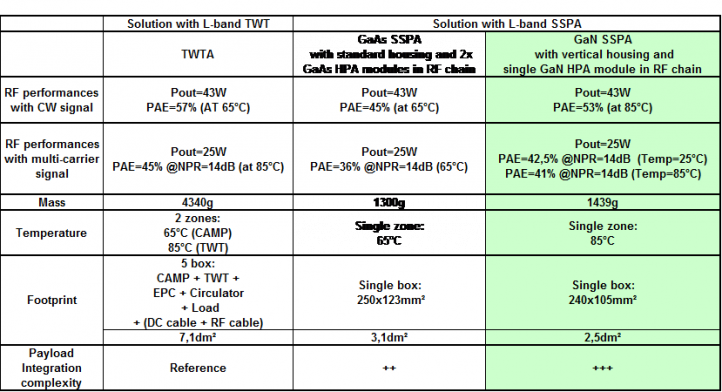
-
StatusCompleted
-
Status date2019-07-09
-
Activity Code5C.126
In the frame of a satellite dedicated to MSS applications (Mobile Satellite Services), analysis about a payload integrating many 50W L-band GaN SSPA units show a strong predominance for the footprint criterion. Based on these analysis, a vertical structure needed to be used for this new 50W L-band GaN SSPA product. Furthermore, it has been demonstrated that a solution with a vertical housing brings 20% of footprint reduction compared to a solution with standard housing. A delta mass of 200g has been estimated between L band SSPA with standard housing (mass reference) and a L-band SSPA with vertical housing (mass reference + 200g): this represents a limited impact (+20kg)for the payload mass which includes 100x SSPA units. A Trade-Off between LTWTA and GaN SSPA solutions has been conducted. Results are presented in table below and showing the positive impact of the GaN SSPA introduction into the satellite payload:


To answer to the requirements imposed by the technical aspects described below, the thermal efficiency of the new equipment structure must be improved:
- A vertical architecture imposed by the objectives of a reduced footprint equipment
- A high temperature (+85°C in acceptance) for flight operating mode
A high heat flux at the interface of the satellite panel and linked to the use of GaN technology for power RF section
This competitive EM GaN SSPA equipment is able to address the entire renewal market of constellations of mobile communications satellites. This L-band GaN SSPA solutions brings many benefits compared to LTWTA solution and GaAs SSPA solution:
- Improved electrical performances with multi-carrier signal
- Higher operating temperature: 85°C instead of 65°C
- Mass reduction of 66% compared to a L-band LTWTA solution
- Footprint reduction of 65% compared to a L-band LTWTA solution
- Simplified implementation during payload integration
Cost reduction compared to LTWTA solution
The GaN HPA module based on UMS GH50 power bar is using a novel hermetic high dissipative package with Metal-Diamond material.
The horizontal mechanical structure including the GaAs&GaN RF chain is using an innovative thermal management solution in order:
- to improve the heat flux at the SSPA interface with satellite panel
- to reduce the junction temperature of RF GaN devices and the maximum temperature of the high power isolator
The vertical mechanical structure including the EPC-TMTC card is including thermal management solution in order to reduce temperature of DC components and minimize also the thermal gradient linked to the vertical organization
The EPC-TMTC card is based on new substrate’s material with improved thermal conductivity
The development effort is focused on the 4 main parts of the SSPA equipment : • The linearized RF section including a GaN output section (MLA+HPA). The UMS GH50 technology is used; • The DC/DC section (EPC card) designed to cope with the new RF GaAS and GaN section, the thermal constraints (Tcase=85°C) and the mechanical constraints(EPC card used in vertical position, new material used for PCB); • A TMTC section designed to manage the temperature compensation (gain and power compensation), the overdrive Limitation circuit OLC, the bias voltage regulation • A new vertical mechanical structure offering reduced footprint and using thermal management solution to answer to the requirements imposed by the vertical architecture.
The activities are dedicated to the development and the tests of this EM SSPA equipment:
- Complete detailed trade-off to select thermal management solutions used in the mechanical structure
- Design, manufacturing and test of the GaAs and RF section
- Design, manufacturing and test of the EPC-TMTC card
- Design and manufacturing of the mechanical structure including thermal management solutions selected after a detailed trade-off
- Assembly and test of the EM L-band 50W GaN SSPA
- Initial Electrical Tests (CW and multi-carrier mode)
- Mechanical tests (shocks and vibrations) covering different platforms
- Thermal Vacuum Tests
- Final Electrical Tests (CW, 2tones and multi-carrier mode)
Final review to validate the development and the performance.
All key reviews have been held successfully. The L-band 50W 85°C GaN SSPA has been fully tested with the expected performance.
This L-band equipment would be qualified in the frame of an future ESA ARTES 3-4 study. The contract is now closed.



